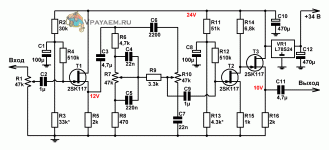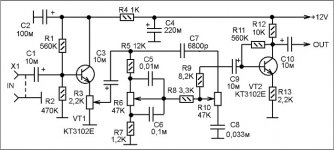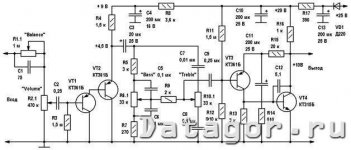class-A
Attachments
How about Putzey's preamp? It's completely transparent if that is what you are after.
https://www.diyaudio.com/community/...well-a-balanced-volume-control-really.279382/
https://www.diyaudio.com/community/...well-a-balanced-volume-control-really.279382/
Well, even though I was looking for SS to begin with, I found a pcb for a 12au7 version of the Starving Student hybrid tube headphone amp in my storage that I apparently purchased a decade ago. A quick search on the internet found a project file on Mouser for the BOM and ordered it. Got some tubes, power supply, and everything minus a case on the way. I could use another headphone amp for the 3rd floor on my house anyway if it doesn't work out on the main system.
I also, potentially, have a built BA2018 pre available to me soon, so even though I didn't build it, it will still be a nice bit to add into my system, especially with the Aleph 30. Keeping my fingers crossed on that one!
I also, potentially, have a built BA2018 pre available to me soon, so even though I didn't build it, it will still be a nice bit to add into my system, especially with the Aleph 30. Keeping my fingers crossed on that one!
I have a BA2018 and I am very pleased with this. Pairs very good with the F5 amplifier.
It wasn't too hard to build either.
It wasn't too hard to build either.
The vast majority of people do not need an external pre amp.
I find it impossible to build a musical sounding system without an active preamp. It clearly serves no obvious technical function...
A TVC is possibly an exception with regards to musicality but at the expense of a limited bandwidth and significant distortion at LF.
Funny, most people are showing you what they built but not listening to what you are asking for. The rolling of the eq sounds like what I hear when using a passive volume control with poor impedance match. For your level I think the BA2018 is a good fit, it is a solid design by Wayne from Pass audio it is well documented in the build thread and sounds good. Preamp/amp paring can also be considered the Aleph30 amps have an early Pass classic sound I still like today. I build almost half a dozen of the Aleph mini and 30 and gifted them to friends and family. The BA2018 to me has a very neutral sound and works well with many amps, I think you will be pleased with it.
Bill
Bill
What kind of chassis is that? I got an acp+ and it would be nice to put it on a nice one!I recently built an ACP+ into a simple chassis
230x330 1U Modushop Galaxy
https://modushop.biz/site/index.php?route=product/product&path=33_286&product_id=245
https://modushop.biz/site/index.php?route=product/product&path=33_286&product_id=245
Lots of good preamps has been mentioned. I just want to add that some headphone amps can serve very well as preamps too. You get benefit of two in one. When you are listening late at night on headphones, just keep amp of.As a relative newb to DIY audio, but having a solid ability to solder and follow directions, though lacking understanding of theory, I see all these amplifier builds, but nowhere near as many preamplifiers to control volume and/or tone? What would be a good beginner level preamp kit or build for someone who already has a nice class A amp? I am finding out that "front end" "line stage" "preamp" and more can all mean the same thing as far as control goes, so it can be very confusing for the beginner. If needed, the amp I'm trying to control is a Pass Aleph 30. I have a phono preamp already, so just a stereo preamp is what's needed. Class A preferred. I've been going cross-eyed trying to figure this section out. Any help from the gurus is appreciated.
Cheers!
Whammy or ACP+ are easy to build.
If you live outside of Europe, no. VAT gets deducted as soon as you choose shipping country.Do you have to pay vat?
I haven't seen this one mentioned yet:
https://www.diyaudio.com/community/threads/ugs-muse-preamp-gb.277355/
Somewhat complex, requires surface mount soldering and some rare dual JFETs (which user RM on this forum sells right now). Based on a Pass design (UGS 3). You would need to obtain a board set, though they do come up for sale occasionally.
https://www.diyaudio.com/community/threads/ugs-muse-preamp-gb.277355/
Somewhat complex, requires surface mount soldering and some rare dual JFETs (which user RM on this forum sells right now). Based on a Pass design (UGS 3). You would need to obtain a board set, though they do come up for sale occasionally.
The store says that the 24v brick won’t work with this, what are you using instead?also added the P089ZB power supply filter which I wholeheartedly recommend. https://diyaudiostore.com/collections/power-supply-kits/products/smps-dc-filter-p089zb-kit
You need to consider the role of an attenuator, You have a phono preamp that amplifies your cartridge , but your other line level sources just need suitable attenuation as a volume control, not amplification. The secret is matching your power amp sensitivity like this one, with input sensitivity that matches consumer line level https://www.diyaudio.com/community/threads/quad-306-an-underrated-masterpiece.254558/page-3 you then can have attenuation in between preserving your source audio capability, and not detracting from it.As a relative newb to DIY audio, but having a solid ability to solder and follow directions, though lacking understanding of theory, I see all these amplifier builds, but nowhere near as many preamplifiers to control volume and/or tone? What would be a good beginner level preamp kit or build for someone who already has a nice class A amp? I am finding out that "front end" "line stage" "preamp" and more can all mean the same thing as far as control goes, so it can be very confusing for the beginner. If needed, the amp I'm trying to control is a Pass Aleph 30. I have a phono preamp already, so just a stereo preamp is what's needed. Class A preferred. I've been going cross-eyed trying to figure this section out. Any help from the gurus is appreciated.
Cheers!
The most flexible approach is always active volume and tone controls, Baxandall topology is the obvious choice as giving good performance allowing both attenuation or gain without loss of headroom, and good channel matching through the use of linear taper pots. You can still do this with all through-hole components too, even now.
Having gain is important, some programme material is at a very low level, if you only have attentuation you are scuppered!
I see this mistake in computer volume controls a lot - you find some video that's got very low audio level and set everything to max, but the volume is not enough (yes, the system is arranged so it cannot clip, but I'd rather be able to listen to that quiet source without having to resort to headphones).
Having gain is important, some programme material is at a very low level, if you only have attentuation you are scuppered!
I see this mistake in computer volume controls a lot - you find some video that's got very low audio level and set everything to max, but the volume is not enough (yes, the system is arranged so it cannot clip, but I'd rather be able to listen to that quiet source without having to resort to headphones).
i disagree, adding active circuitry just invites reactance and noise detracting and blurring from capability of the source. The task you are attributing to active volume, is not thinking outside of the square , where passive resistance can be arranged and can be made adjustable. Describing a circuit that does this for lower volume imagine a L pad providing 25 mega ohm series resistance on the series element at zero volume, and not relying on the shunt element at all for achieving silence at zero , The shunt element commencing at 1.25K at zero then largely at lowest volume does not interfere with the source impedance. As volume progresses it just gets better for such a passive, with then also ability to adjust the shunt element upward further as music taste dictates at any volume setting.
.
.
@Chris Daly adding active devices does not necessarily add noise. In Doug Self’s book on small signal circuits there is a section on “how to attenuate quietly”. In this he demonstrates that at typical signal levels and circuit impedances you will improve the signal to noise ratio by 15db by using op amps rather than passive circuits.
This is solid, repeatable and measurable. His sample used a 5532. There are quieter opamps than this now.
This is solid, repeatable and measurable. His sample used a 5532. There are quieter opamps than this now.
- Home
- Source & Line
- Analog Line Level
- So many amplifier builds, what about preamps?


